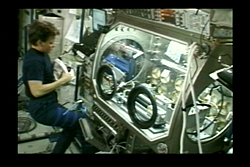
The experiment is on structural and rheological transitions of field-responsive fluids in microgravity and was transported to the space station by the space shuttle Discovery, which lifted off in October.
Eric Furst, UD associate professor of chemical engineering, and his postdoctoral researcher Paula Vasquez developed the experiment as part of the InSPACE2 (Investigating the Structure of Paramagnetic Aggregates from Colloidal Emulsions) program.
Furst said a long-standing aim of complex fluid rheology has been to identify the fundamental roles that interactions on nanometer and micrometer length scales play in determining the rheological properties of these materials. Among the many types of complex fluid systems of interest, he said magnetorheological (MR) fluids provide a stunning example.
MR suspensions exhibit a rapid transition from a liquid- to solid-like state upon the application of a magnetic field, Furst said, explaining that the MR effect is due to induced interactions between dispersed, micrometer-sized superparamagetic particles. This rheological transition has the potential to provide the basis for technologies, ranging from actively controlled dampers and actuators to magnetically sealed bearings and sensitive stress transducers.
Applications to space exploration, he said, include potential use in robots, rovers and crew suits, with mobility augmentation, especially for endurance and fatigue countermeasure designs that aid in lifting, moving and supporting loads during extra-vehicular activities.
Furst said the MR fluid samples are being studied in the Microgravity Science Glovebox aboard the International Space Station. He said the space station commander, Peggy Whitson, has taken special interest in the experiments and has volunteered her time during Saturdays to push the programmed operations ahead. Furst and Vasquez monitor the experiments live at UD through a video link to the International Space Station and in conjunction with the Tele-Sciences Center at NASA's Glenn Research Center. There, project scientist Juan Agui and support staff communicate with Whitson, answering questions and providing feedback.
The objectives of the study are to understand, at a microscopic level, the structure formation, percolation and stress transduction mechanisms of MR fluids in an environment free from gravitational effects, such as sedimentation. By studying the behavior of these samples under the influence of magnetic fields in a microgravity environment, the team hopes to gain a better understanding of the physics of these unique materials, Furst said.
Furst joined the UD faculty in 2001. He received a bachelor's degree from Carnegie Mellon University and a master's degree and doctorate from Stanford University. He did postdoctoral work at the Institut Curie in Paris.

